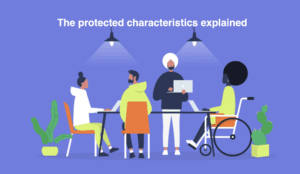The protected characteristics explained.
The Equality Act 2010 identifies nine characteristics as “protected characteristics,” which are subject to significant discrimination in areas such as employment, access to goods and services, education, and healthcare.
If someone experiences discrimination based on any of these protected characteristics, they should seek guidance from the HR department, their line manager or person of authority.
Age
Age discrimination can affect both young and older individuals. Young people may face barriers to employment due to lack of experience, while older people may encounter difficulties based on societal perceptions of their ability to keep up with technology. The law in the UK no longer sets a default retirement age, allowing individuals to work as long as they wish, as long as they meet the role requirements.
Employers should consider providing vocational or non-vocational training opportunities to young people to increase their chances of entering the workforce.
Disability
The Equality Act defines disability as a physical or mental impairment that substantially and long-term affects a person’s ability to carry out daily activities. The definition considers both physical and mental impairments, including conditions like clinical depression, schizophrenia, and bipolar disorder. Some conditions, such as cancer, HIV/AIDS, and multiple sclerosis, are automatically considered disabilities upon diagnosis.
Employers and educational institutions have a responsibility to make reasonable adjustments to support individuals with disabilities. This may include modifications to work or study conditions and the provision of specialised equipment.
Gender Reassignment
Gender reassignment refers to when someone chooses to live in the gender they identify with, rather than their assigned gender at birth. Gender reassignment does not necessarily require surgical or medical interventions, but individuals may undergo a “real life test” of living in their identified gender for at least a year before pursuing surgery.
In workplaces, it is important to respect an individual’s preferred gender identity, including the use of correct pronouns. Refusing to use the correct pronouns can undermine an individual’s confidence and may constitute harassment. Personal data regarding an individual’s gender history must be kept secure. Individuals who have undergone gender reassignment are entitled to use facilities corresponding to their identified gender.
Marriage and Civil Partnership
This protection applies to individuals in formal legal partnerships, including same-sex marriages and civil partnerships. It does not cover cohabiting couples without a formal affirmation of their relationship. Protection may relate to pension rights, financial compensation in the workplace, and inclusive workplace cultures.
Pregnancy and Maternity
Pregnant women and those caring for new-borns or young children are protected from direct and indirect discrimination. Employers should conduct risk assessments to ensure the safety of pregnant women and make necessary adjustments to roles and working conditions. Flexible working arrangements, breastfeeding facilities, and childcare opportunities contribute to supporting this protected group.
Race
Race protection covers discrimination based on ethnicity, nationality, national identity, skin colour, and caste. Religion and language often influence ethnicity. Different conflicts, tensions, and biases can arise based on race, nationality, or national identity. Minority ethnic groups may face challenges in educational attainment, employment, and representation in strategic positions.
Religion or Belief
This characteristic protects individuals who follow religious beliefs as well as those with no religious or belief system. Efforts should be made to avoid scheduling meetings and events on significant faith days to ensure inclusivity. Dietary requirements should also be considered. Extremist behaviour motivated by religion or belief should not be generalised to the entire faith group.
Sex
Both men and women are protected from discrimination based on their sex. Women often face issues related to pay disparities and underrepresentation in senior positions. Men may also experience discrimination when pursuing careers in traditionally female-dominated fields. Sexual harassment, which includes unwanted conduct of a sexual nature or conduct based on sex, is also covered under this protected characteristic.
Sexual Orientation
Sexual orientation protection extends to all individuals, regardless of their actual or perceived sexual orientation. Discrimination or harassment based on sexual orientation or association is prohibited. Negative social influences and fear of reprisal can still prevent individuals from openly expressing their sexual orientation.
These examples illustrate instances of discrimination related to sexual orientation, including homophobic language, denial of services to same-sex couples, and verbal or physical abuse based on perceived or known sexual orientation.

